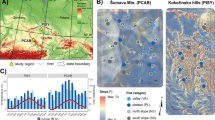Abstract.
Controls of fine dynamics were investigated in a Pinus palustris Mill. (longleaf pine) woodland subjected to two understory vegetation treatments (control versus removed) and four overstory treatments (no gap control, and canopy gaps of three sizes with constant total gap area per stand). Fine root (<2 mm diameter) dynamics were measured over 11 months using ingrowth cores (all treatments) and minirhizotrons (understory removed in no gap control and large gap treatments only). At the fine (microsite) spatial scale, pine and non-pine root mass production responded negatively to each other (P=0.033). Each life form was significantly (P≤0.028) related to nearby overstory density, and pine root production compensated for reductions in non-pine roots if understory vegetation was removed. Soil moisture and NO3 mineralization rate were negatively related to pine root mass production (ingrowth cores; P<0.001 and P=0.052) and positively related to pine root length production, mortality and turnover (minirhizotrons; P from <0.001 to 0.078). Temperature variance was negatively related to pine root lifespan (P<0.001) and positively related to pine root turnover (P=0.003). At the ecosystem scale, pattern of overstory disturbance (gap size and number) had no significant effect on non-pine, pine, or total root production. However, the presence of gaps (versus the no-gap control) increased non-pine root mass production (ANOVA, P=0.055) in natural understory conditions, and reduced pine root mass production (P=0.035) where the understory was removed. Ecosystem-wide pine root length production, mortality and turnover were positively related to weekly soil temperature (P≤0.02). In natural systems, fine root dynamics are highly variable and strongly affected by biotic factors. Roots quickly close belowground gaps because one life form (pine or non-pine) compensates for the absence of the other. When understory vegetation is removed, however, pine roots respond to the local abiotic environment, particularly moisture and NO3.
Similar content being viewed by others
Author information
Authors and Affiliations
Additional information
Electronic Publication
Rights and permissions
About this article
Cite this article
Jones, R.H., Mitchell, R.J., Stevens, G.N. et al. Controls of fine root dynamics across a gradient of gap sizes in a pine woodland. Oecologia 134, 132–143 (2003). https://doi.org/10.1007/s00442-002-1098-y
Received:
Accepted:
Issue Date:
DOI: https://doi.org/10.1007/s00442-002-1098-y




